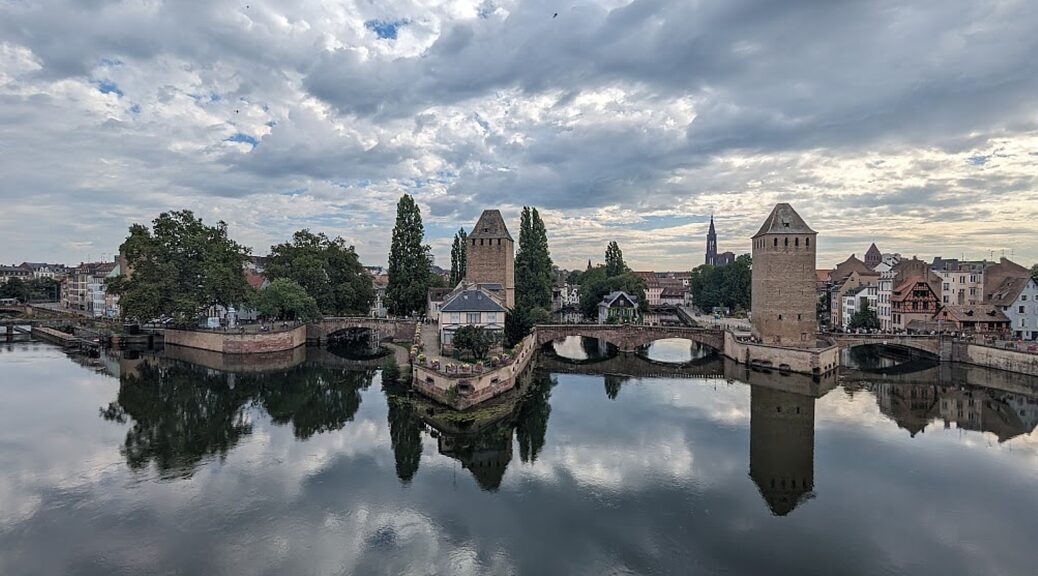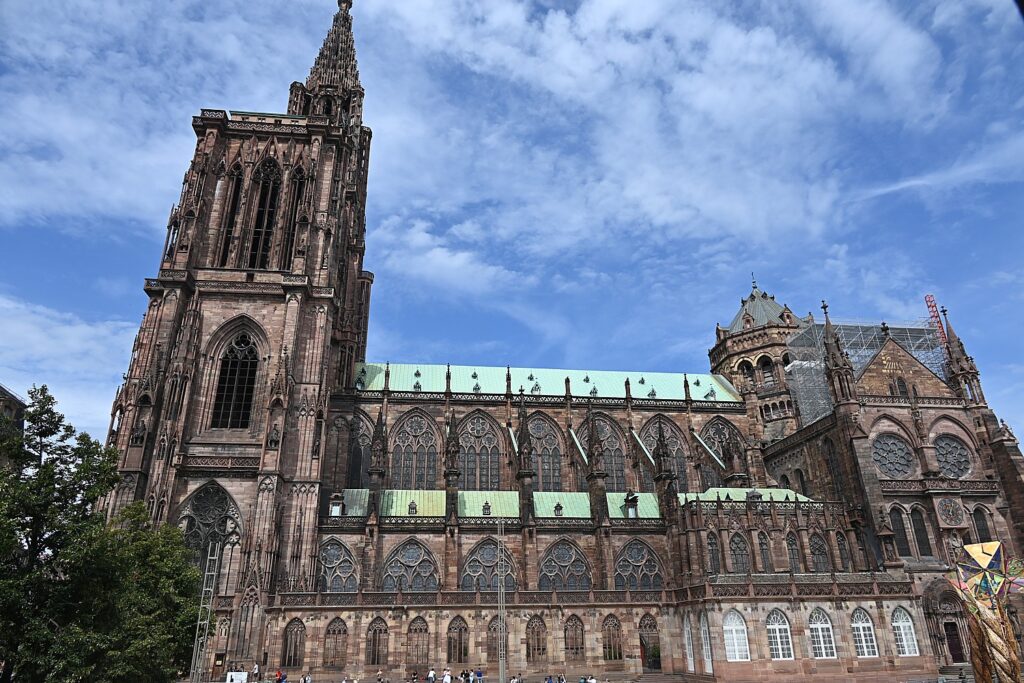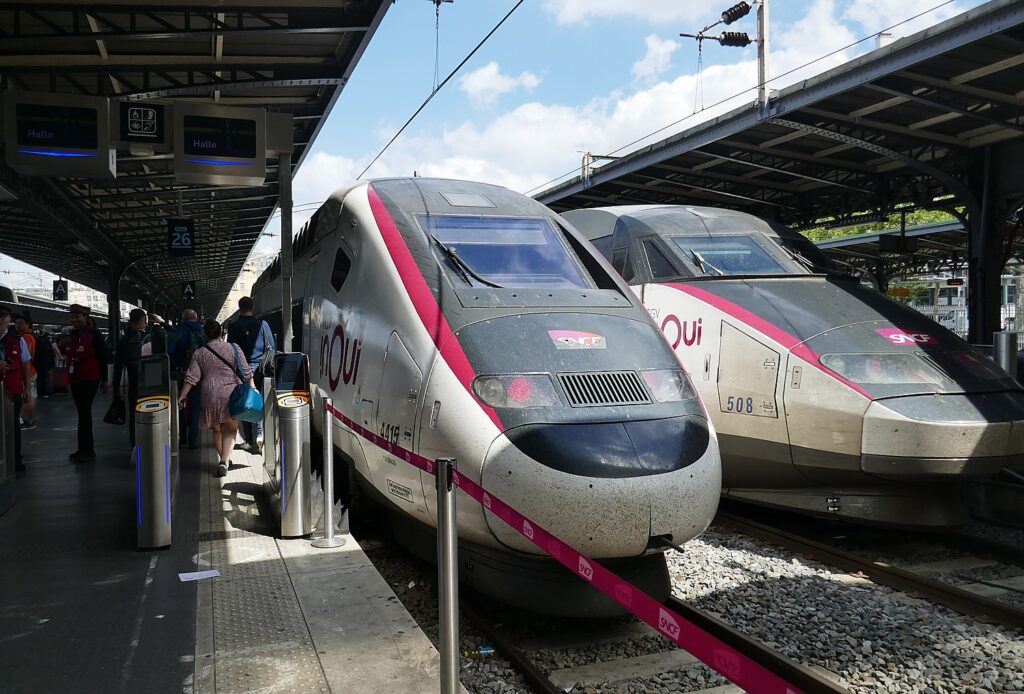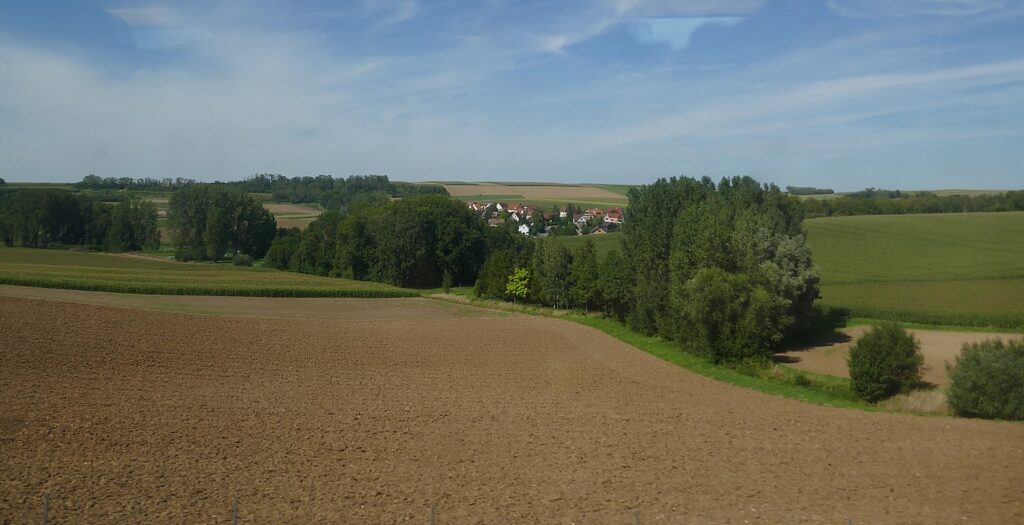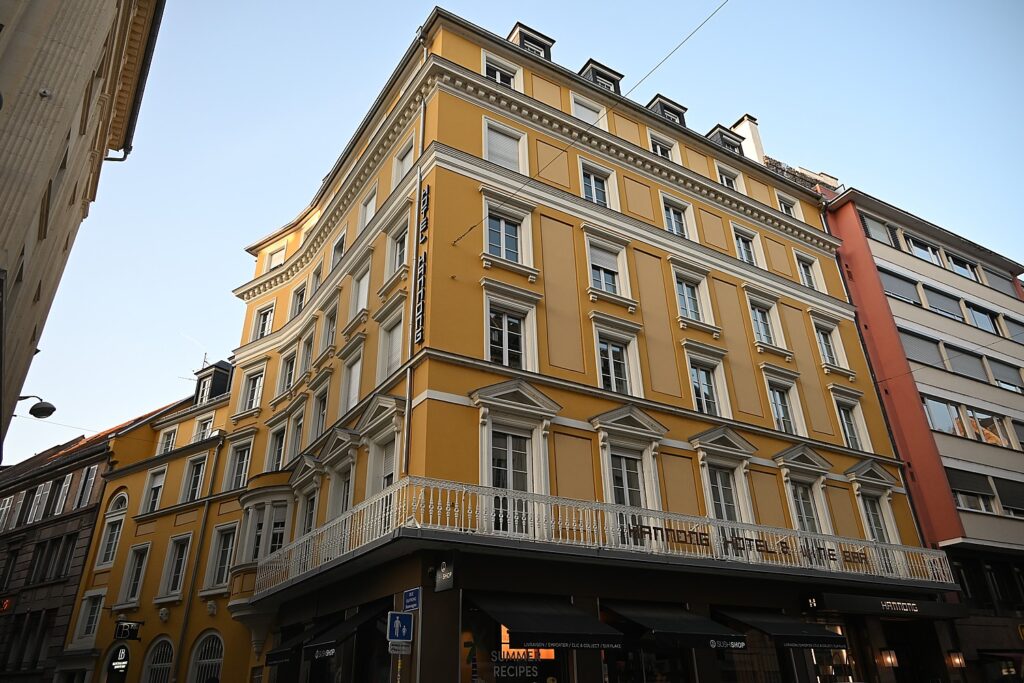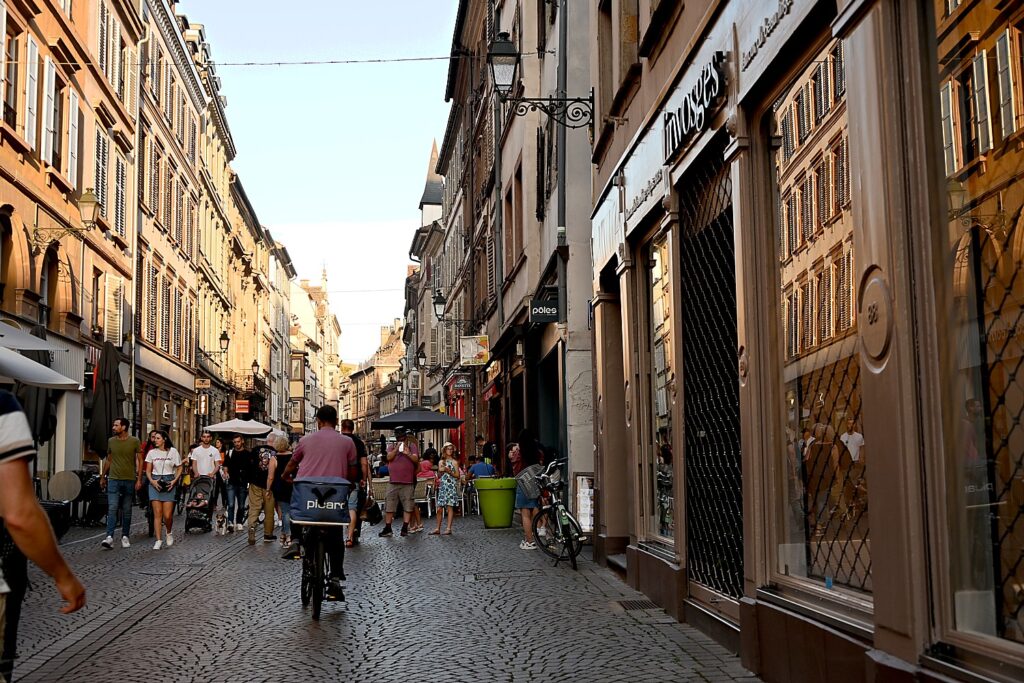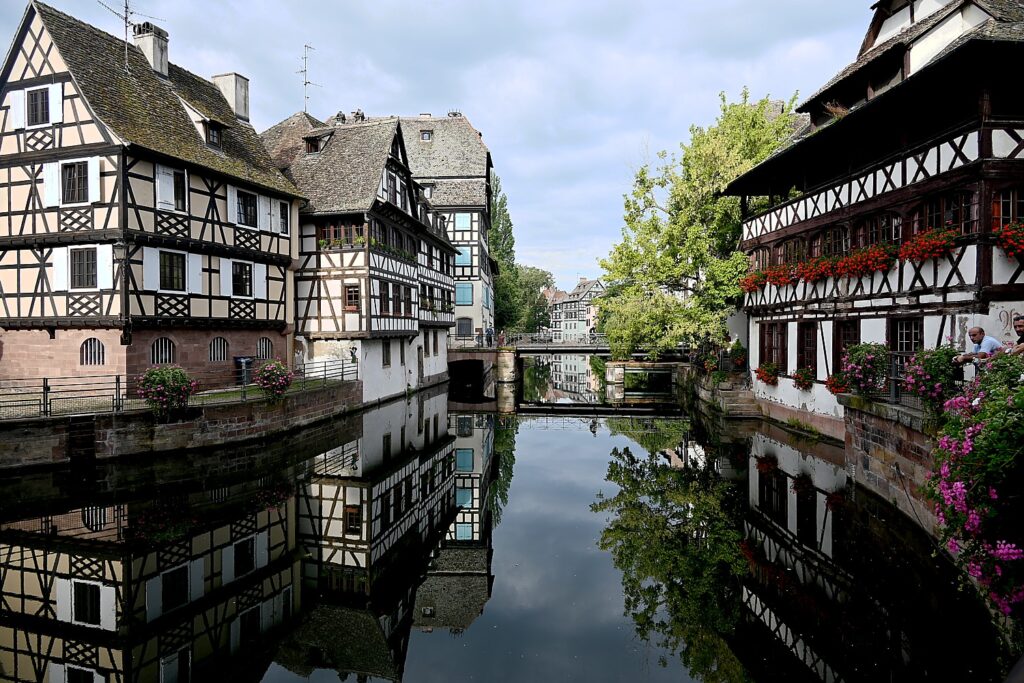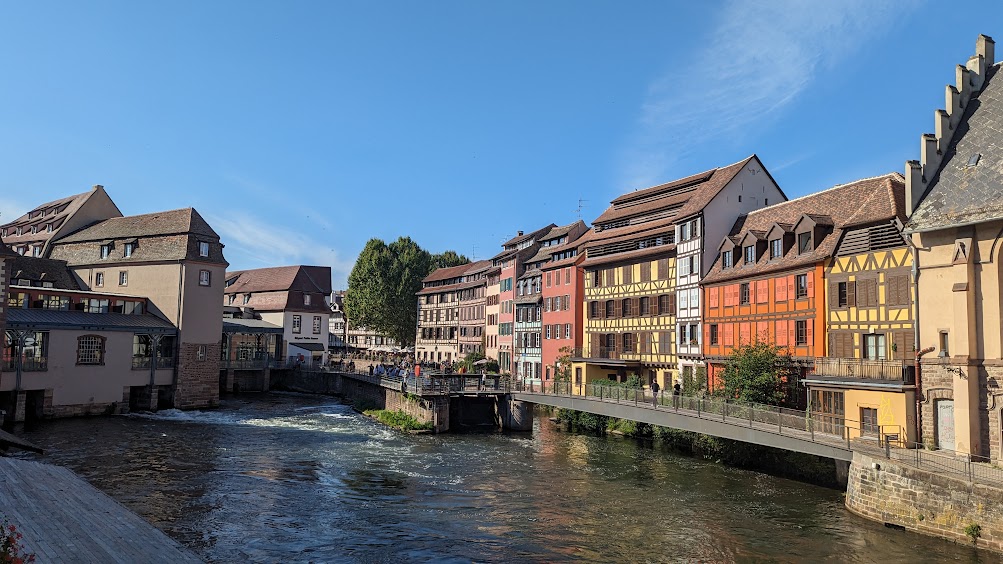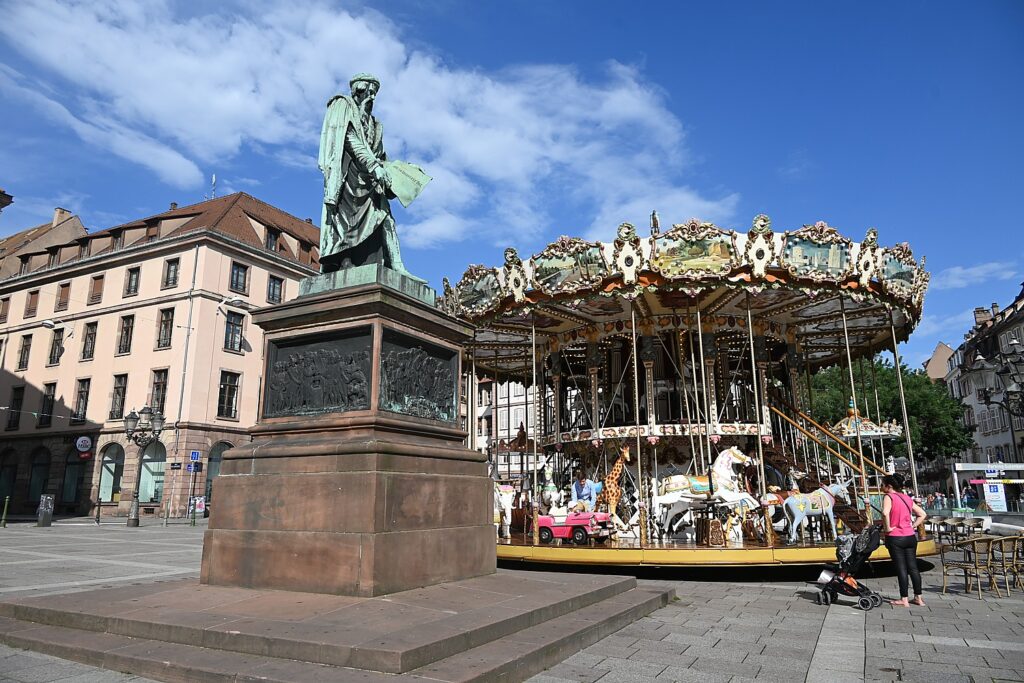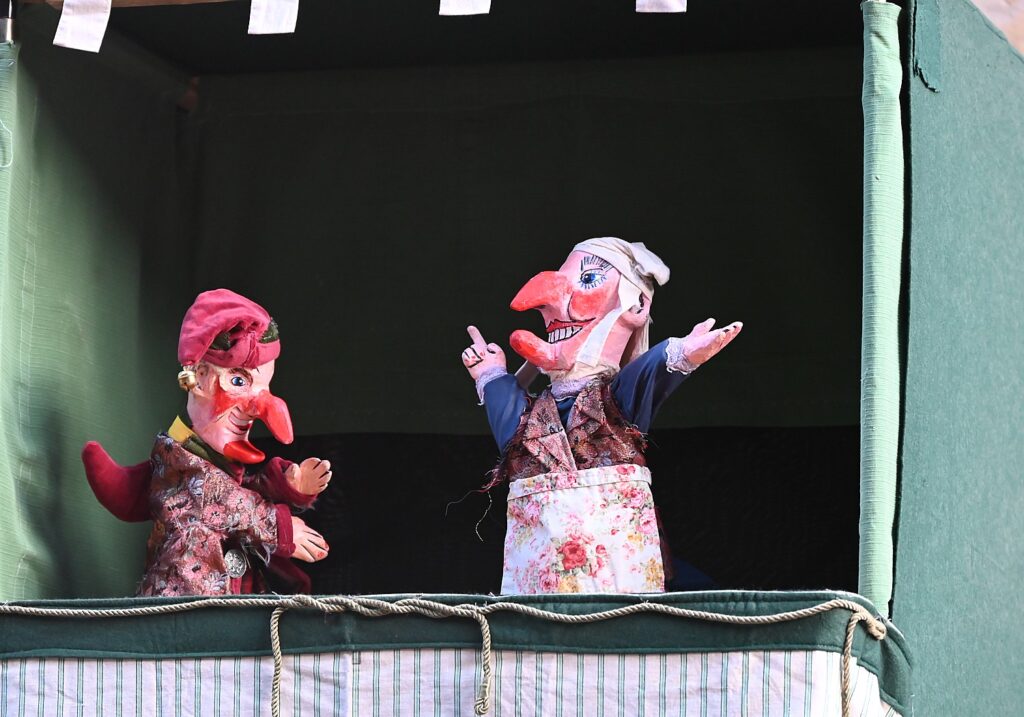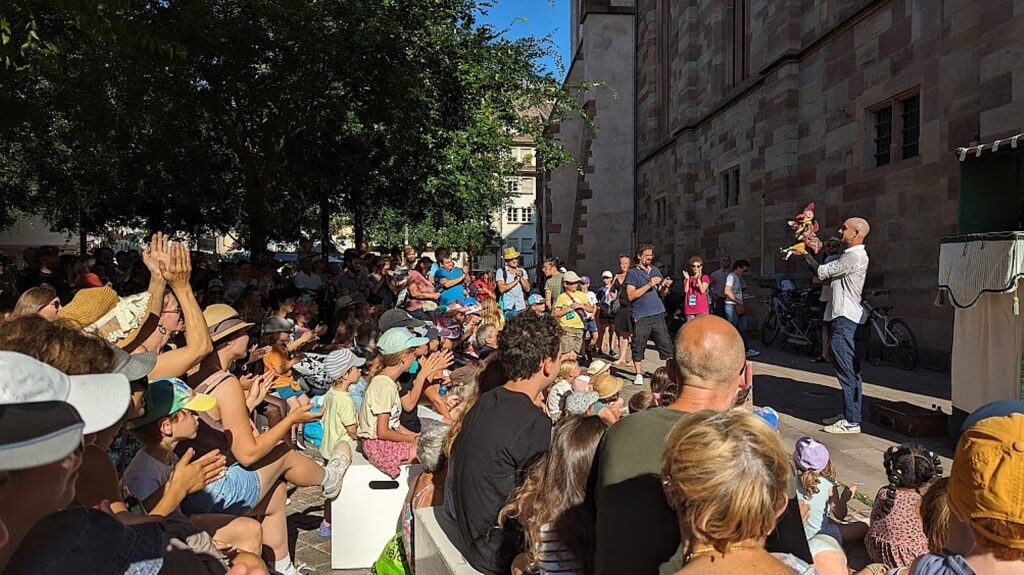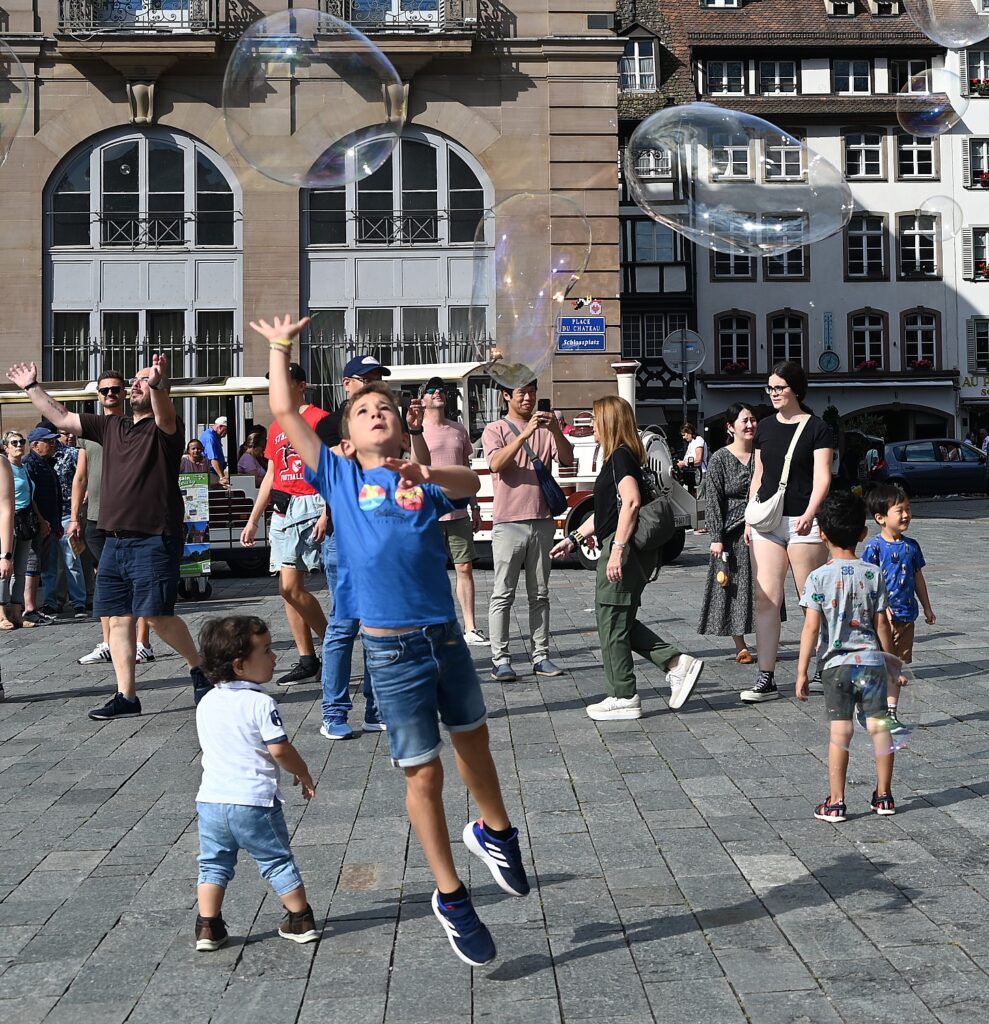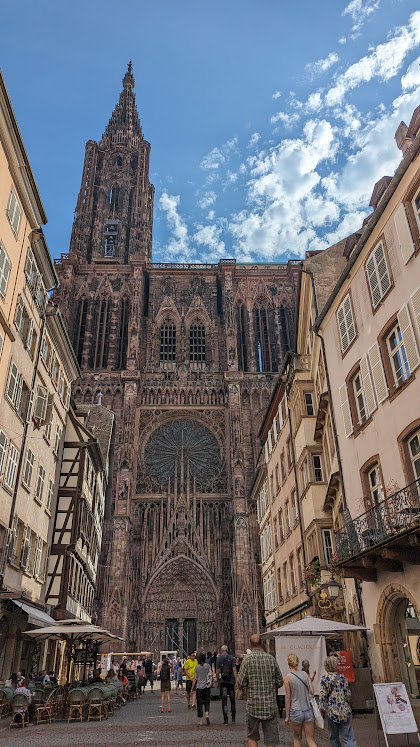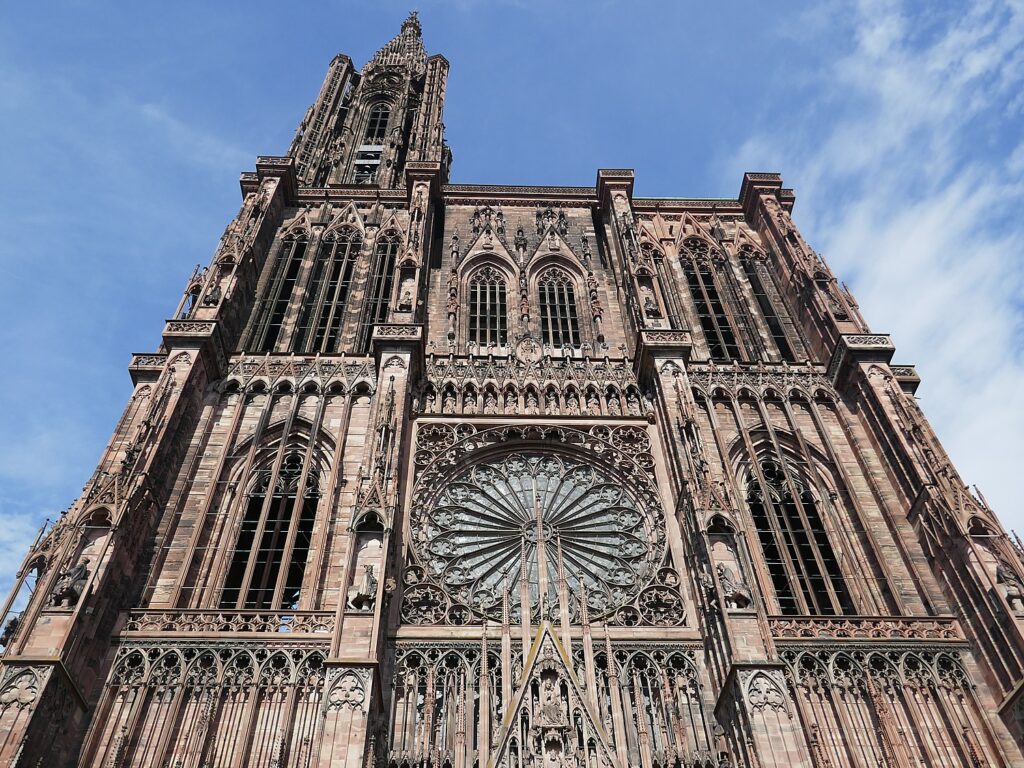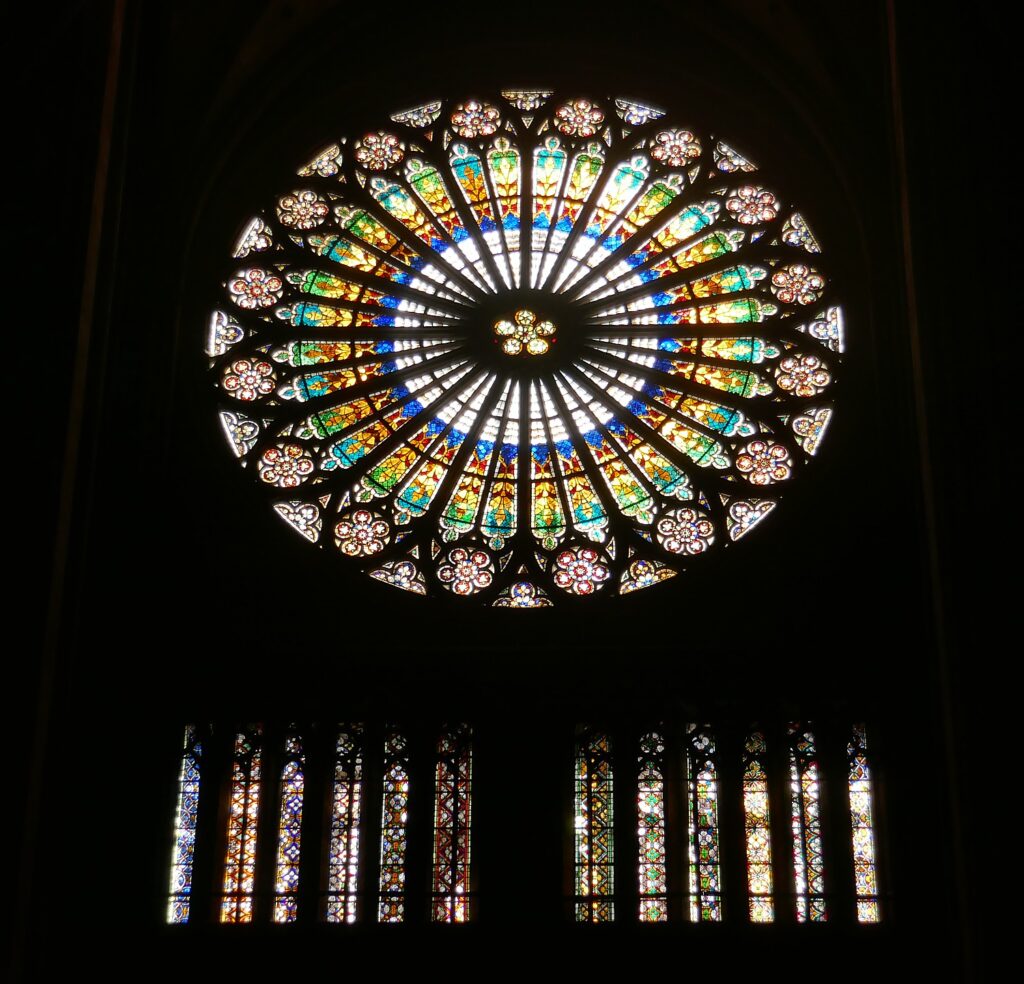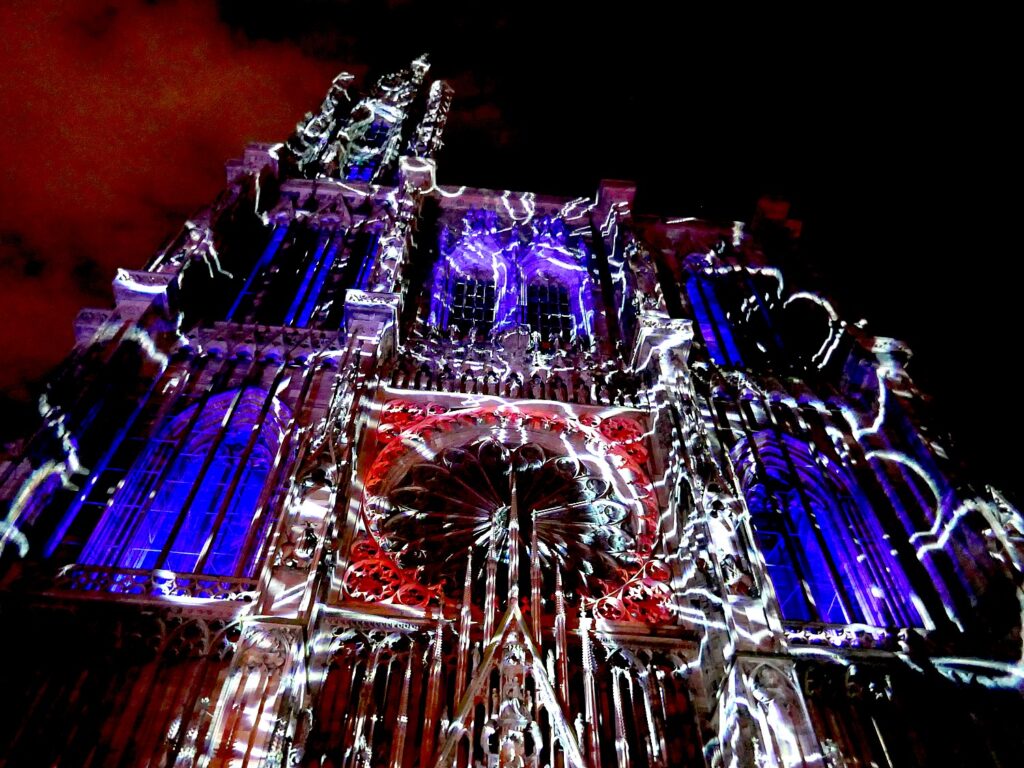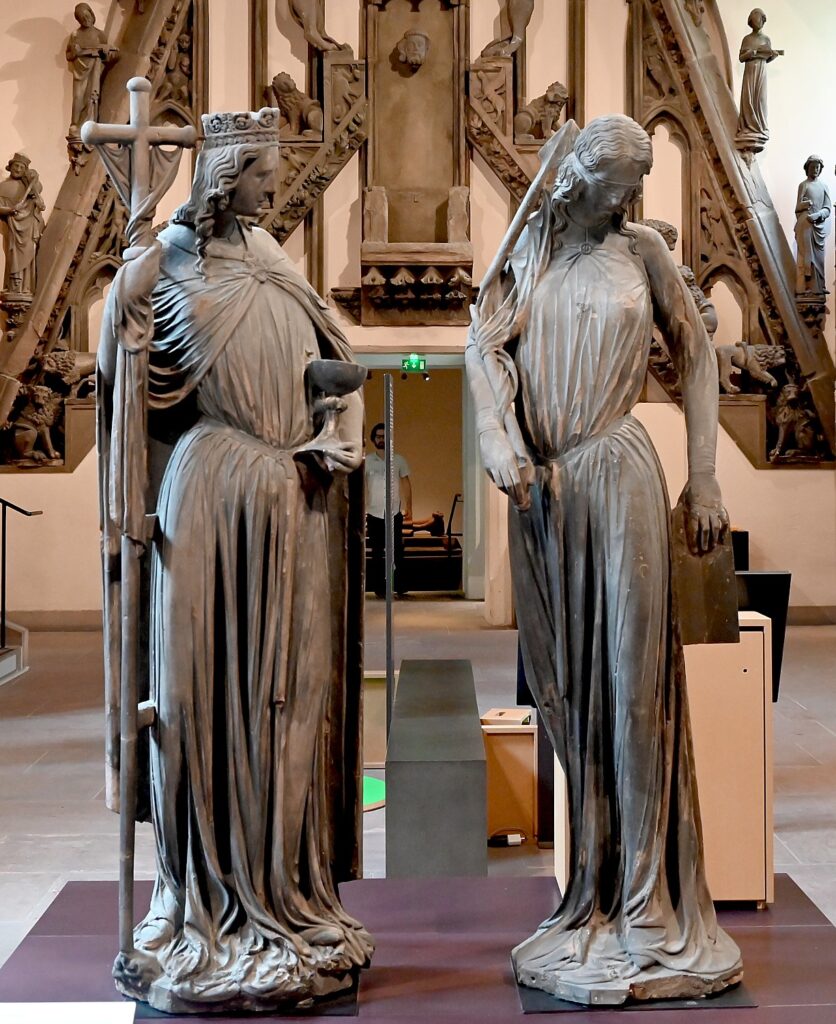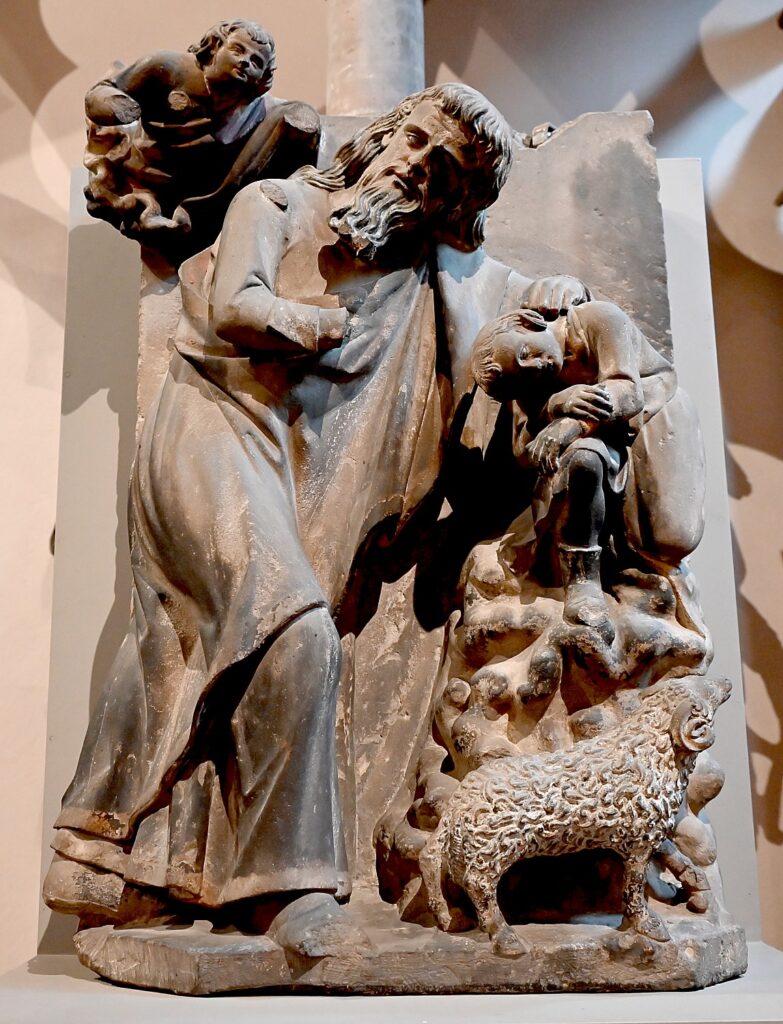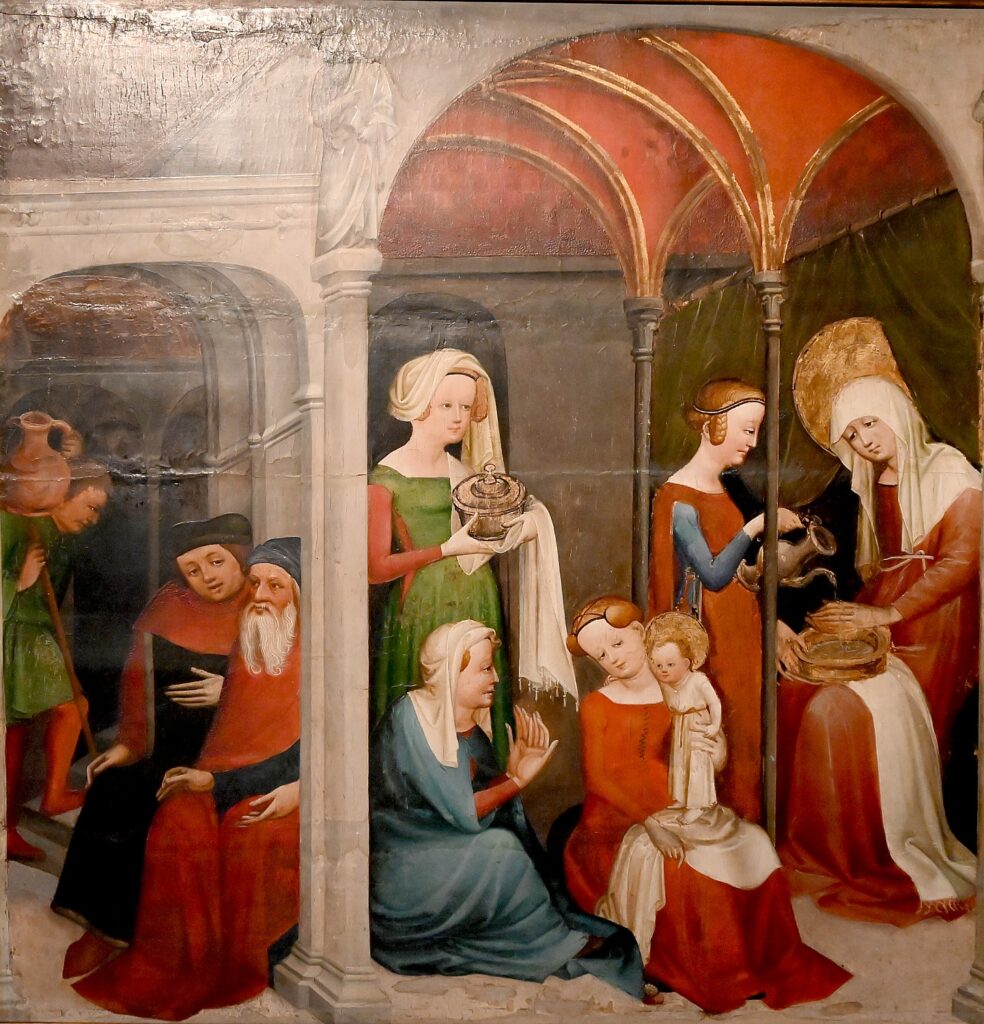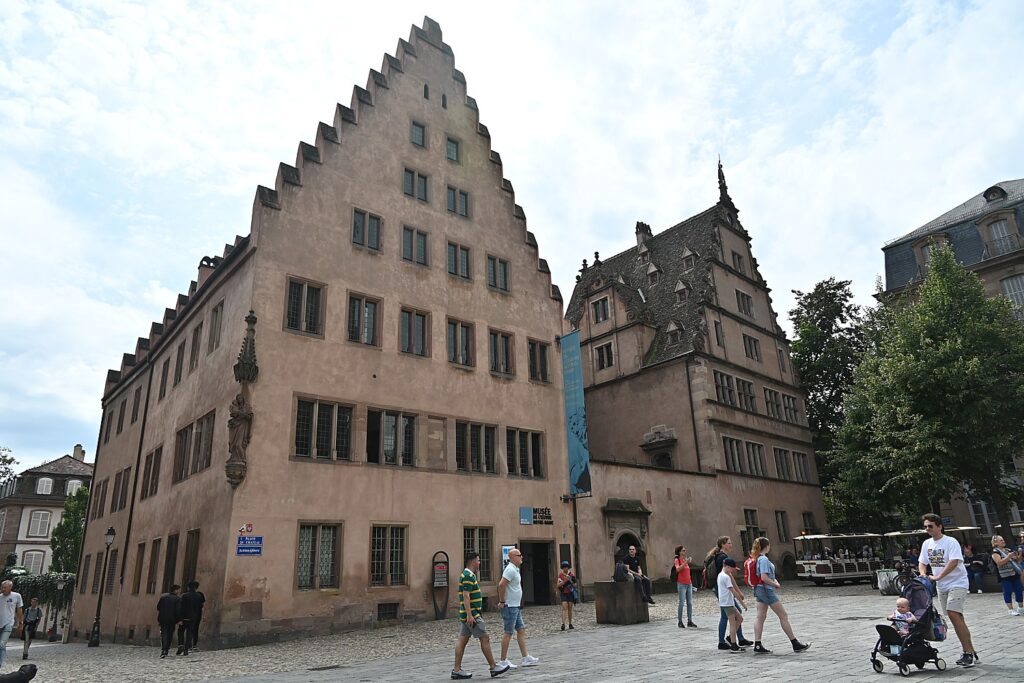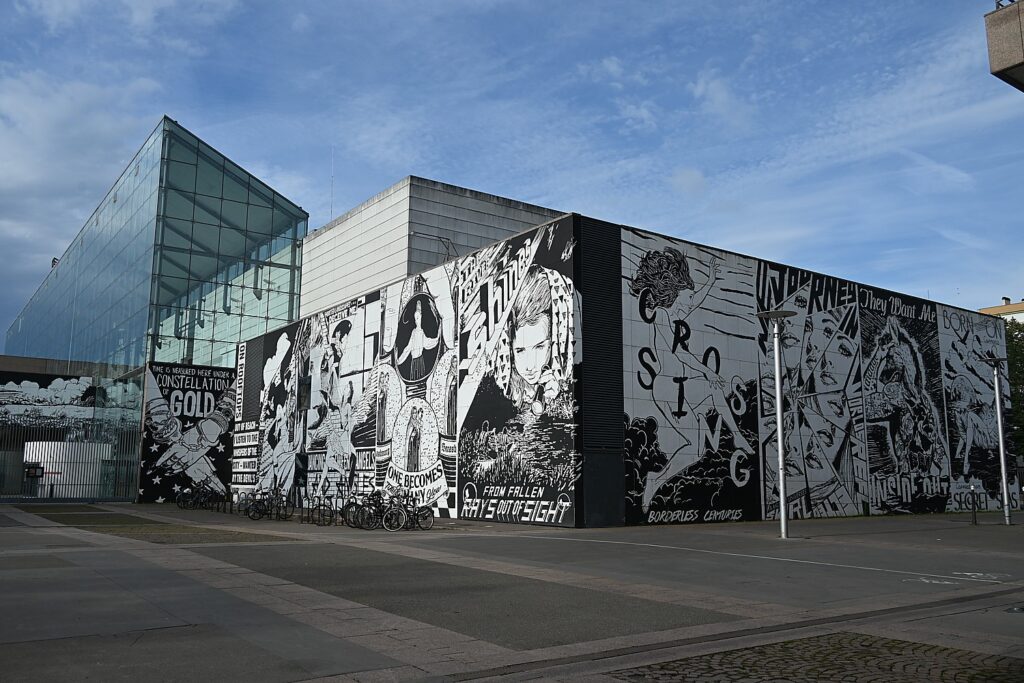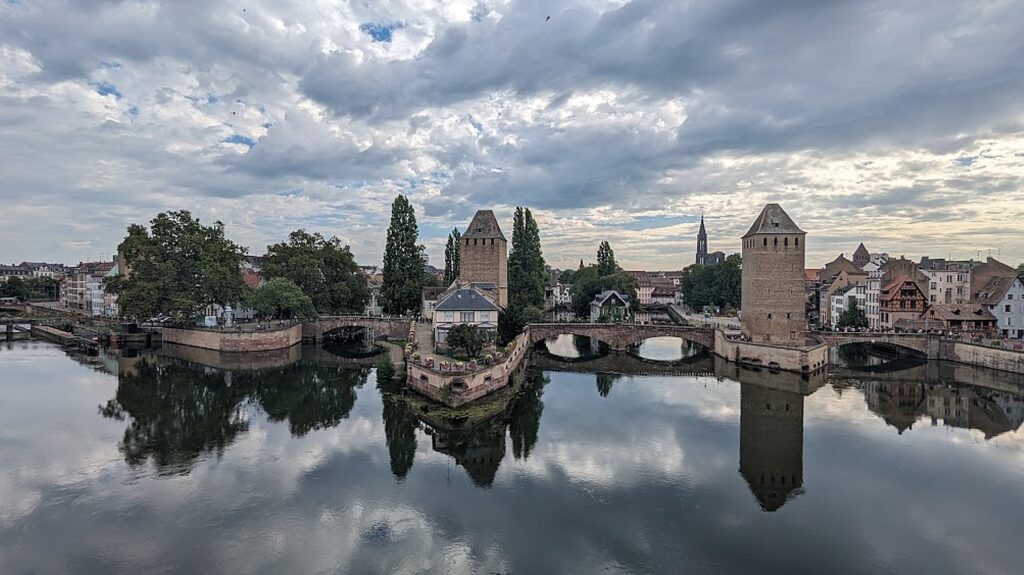
By Karen Rubin, Travel Features Syndicate, goingplacesfarandnear.com
Staying over in the historic city of Strasbourg in France’s Alsace-Lorraine region, means that you can go out in the early morning, before the daytrippers crowd the streets, and soak in the atmosphere.
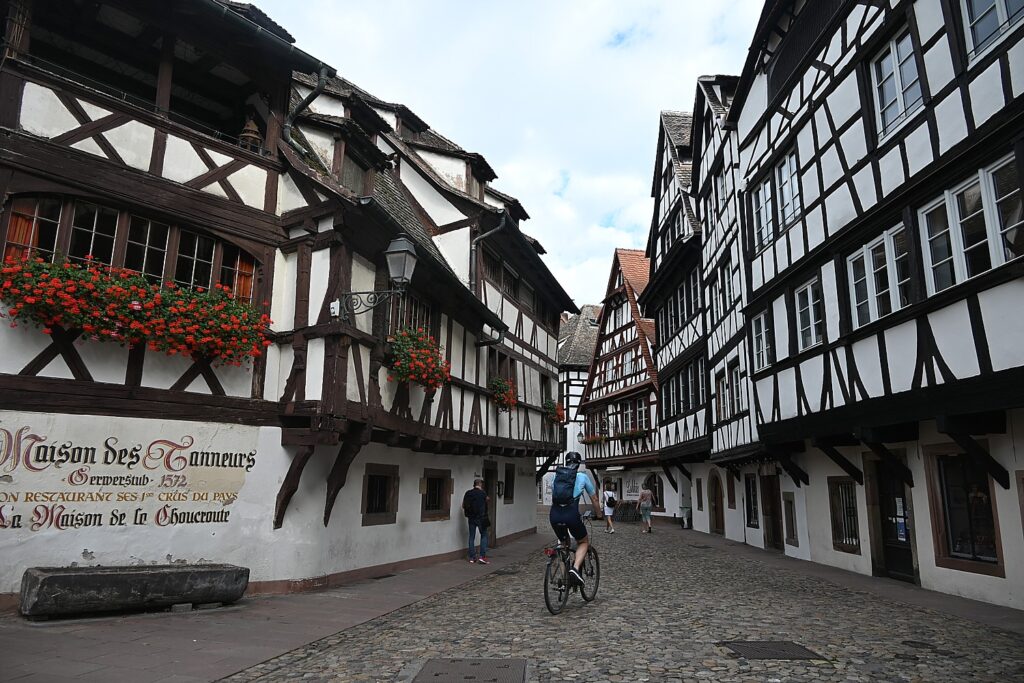
I walk through Tanners Row, which in this early morning hour, is peaceful. A guy on a bike rides through, a reminder that this is still a neighborhood, a community.
I go to explore Strasbourg’s Les Ponts Couverts and the Vauban Dam, located a short distance from each other.

Les Ponts Couverts (covered bridges) are three bridges spanning the River Ill, dominated by three imposing square towers, vestiges of the 13th-century city walls. A bit further, there’s a fourth tower nicknamed “the executioner’s tower.”
While I fruitlessly look for covered bridges, I finally realize that they were replaced in 1865 by these stone bridges without a roof (so not covered),where I am standing. As I observe the beautiful views from the bridge, a fellow tells me you can walk on the Panoramic Terrace on top of the Vauban Dam – in fact, the views from there are spectacular.
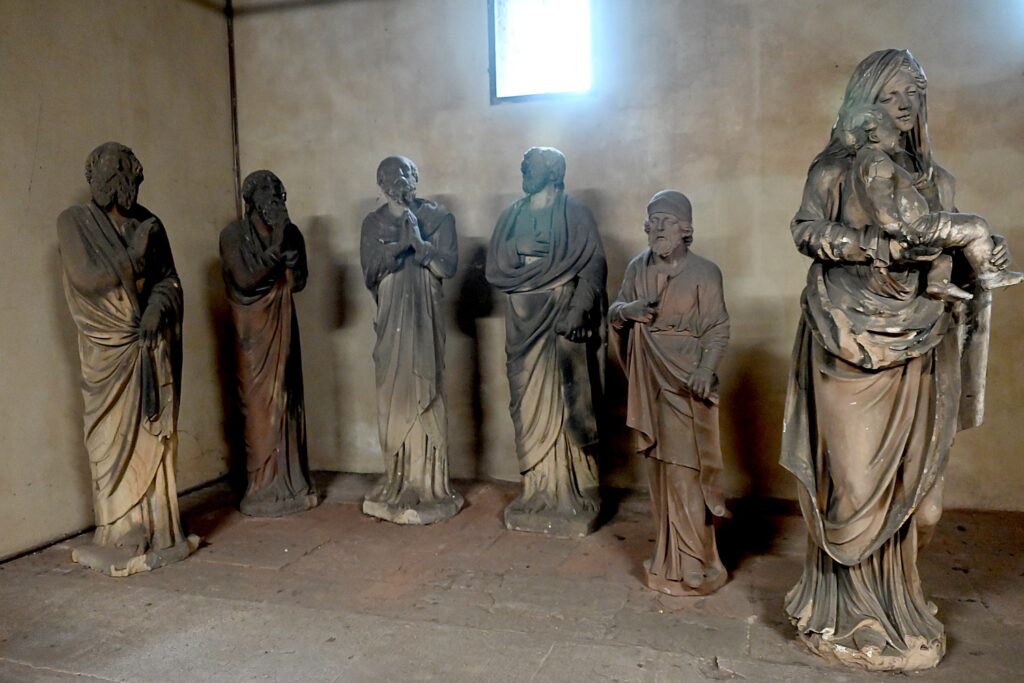
A short walk from the bridge is the Vauban Dam. “The Great Lock” was built between 1686 and 1700 based on plans of Louix XIV’s military engineer, Vauban. Built with 13 arches, it was constructed so that they could flood part of the city to defend against an enemy attack. It is fascinating to walk through – some sculptures just hanging about gathering cobwebs – but most marvelous is a rooftop terrace, laid out in 1965, which you can walk over for a spectacular panoramic view of the old city.
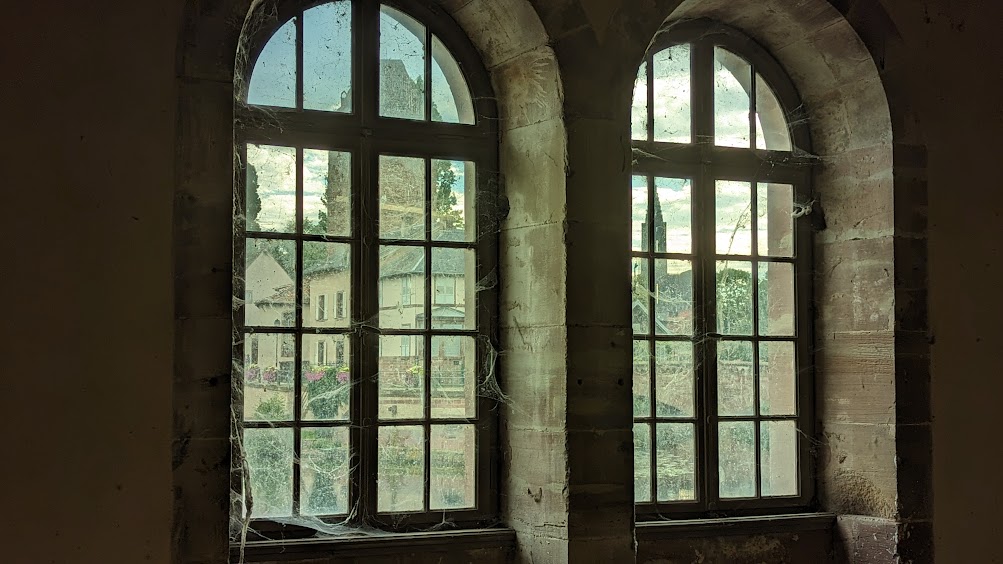
From here, you can see the fingers of the River Ill coming together below you. (Pro tip: though amazing to see in the morning light, you are looking into the sun – the reflections on the water are amazing – but check it out in the late afternoon.)

Palais Rohan
One of the many jewels of Strasbourg is the Palais Rohan. Constructed between 1732 and 1742 from blueprints by Robert deCotte, First Architect to the King, it was built for Cardinal Armand-Gaston de Rohan-Soubise, Prince-Bishop of Strasbourg, modeled after Paris’ grand mansions.

Following the French Revolution, the palace became the Emperor’s royal residence, and after 1870, a museum. Today, the Palais Rohan houses three stellar museums: the Archeological Museum, the Museum of Decorative Arts and the Fine Arts Museum – just walking through the palace to the various rooms where the exhibits are displayed is a phenomenal experience.
(I have to rush through in the couple of hours before I need to get to the Regent Petit France Hotel where we are getting picked up for the European Waterways canal cruise aboard the Panache. It would have been better to have four hours.)
The art and artifacts are gorgeously presented in an exquisite palace. Definitely follow the helpful “My First Visit…” brochures which detail where to find the highlights.

The Museum of Fine Arts presents a fascinating overview of European painting up to 1870. Located on the first floor of the Palais Rohan, the museum offers a tour through the centuries and schools: Italian and Flemish Primitives (Giotto, Memling); Renaissance and Mannerism (Botticelli, Raphael, Veronese, Lucas de Leyde, El Greco); Baroque, Naturalism and Classicism in the 17th and 18th centuries (Rubens, Vouet, Zurbarán, La Belle Strasbourgeoise de Largillière, Canaletto, Tiepolo, Goya); 19th century (Delacroix, Chassériau, Corot, Courbet).
Among the highlights is La Belle Strasbourgeoise, from 1703, a portrait of a woman from one of Strasbourg’s important families in the time of Louis XIV with her imposing two-cornered hat in black lace, painted by one of the best portrait painters of the time, Nicolas de Largilliere. Though the woman has never been identified, the painting has become a symbol of the museum, much as the Mona Lisa is to Le Louvre.
Museum of Decorative Arts is set in the historical apartments – so you visit the chambers of the King and the Bishop-Prince, with exceptional examples of “the princely style of life under the monarchy.” It continues into the wing of the old stables with a tour of rooms housing decorative arts collections tracing the diversity and development of applied arts in Strasbourg from 1681 to 1870 – world-famous Hannong ceramics, furnishings, sculpture and paintings, timepieces, metalwork, silver and goldsmith art, and a selection of mechanical toys from the Tomi Ungerer Foundation.

The most interesting section is the Chamber of the Bishops – the suite of rooms forming the King’s apartments. Originally, there would have been portraits of bishops but in 1793, the paintings were burned by revolutionaries who replaced them with allegorical figures of the Civic Virtues, which is what we see today. One of the paintings dates from the First French Empire and displays the monogram of Napoleon I and the Empress Josephine.
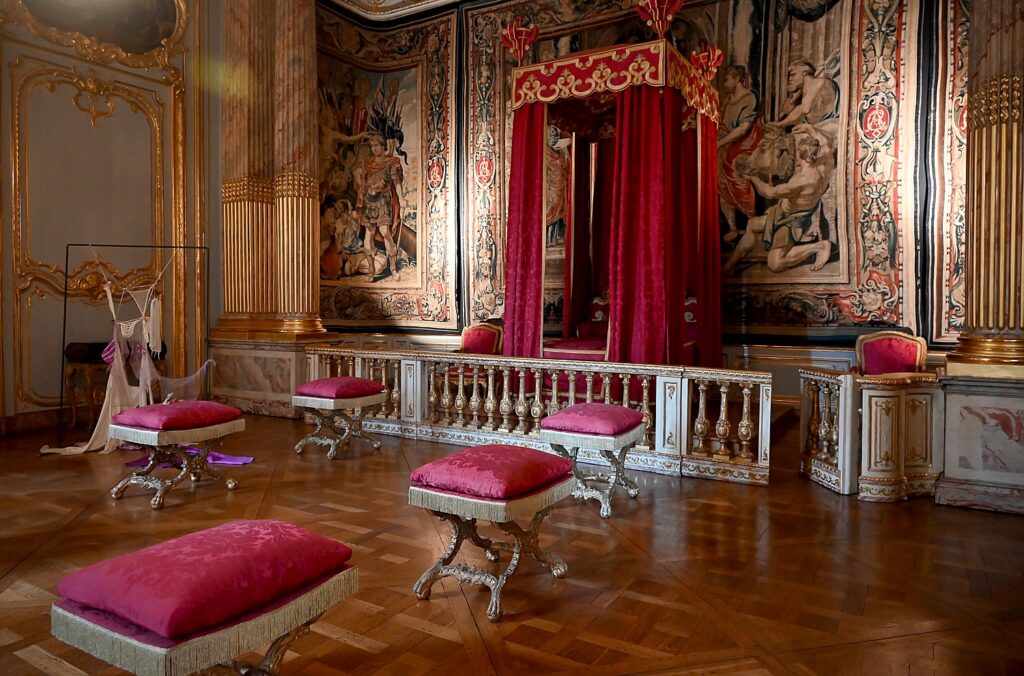
Among the notable occupants of the King’s bedchamber were Louix XV, himself, who stayed here in October 1744, and the Daughines Marie-Josephe de Saxe in 1747 and Marie-Antoinette in 1770. The wood paneling is among the masterpieces of the French Rocaille style. Elaborately stylized shell-like, rock-like, and scroll motifs, Rocaille is one of the more prominent aspects of the Rococo style of architecture and decoration that developed in France during the reign of King Louis XV (1715–74).
Here, there is a disorienting melding of the old with the new: You go through the Royal Suite – bedchamber, Assembly Room which have been complemented with anachronistic modern art displays.
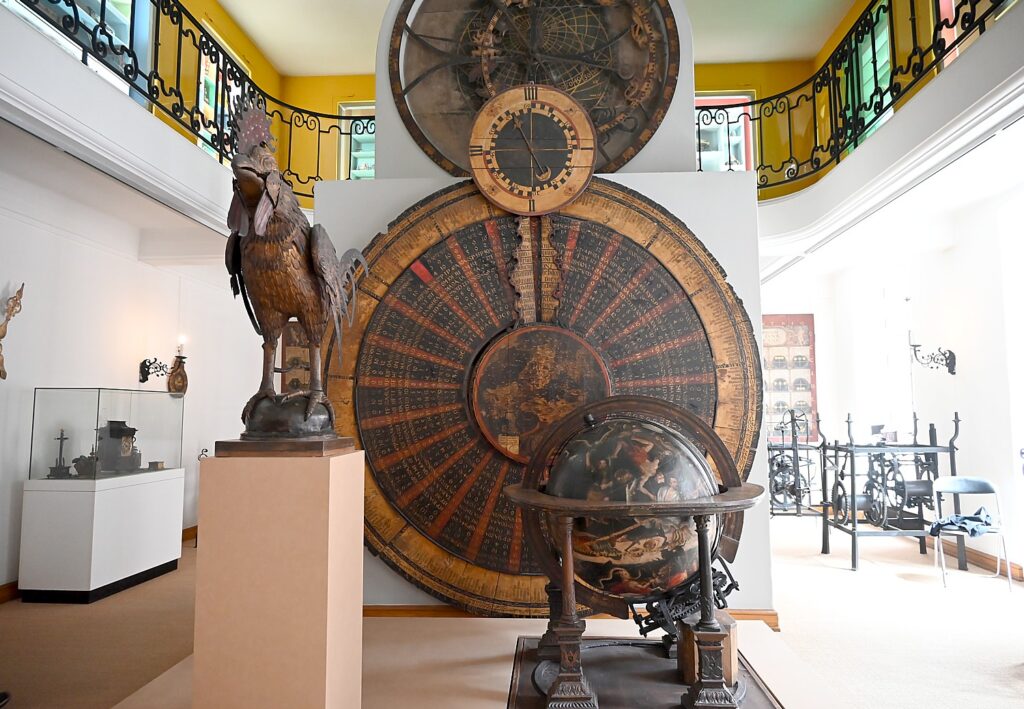
Seeing my interest, the guide directs me to a room with clockworks – the cock clock originates from the first astronomical clock dating from the 14th century of the Strasbourg Cathedral; in the center of the room are parts of the second astronomical clock designed in the 16th century by mathematician Conrad Dasypodius.
I visit a room that originally was the Prince-Bishops’ bedchamber, but when it was refurbished in the Imperial period, the bedchamber became Emperor Napoleon’s Morning Room and the antechamber of the Prince-Bishop became a small dining room. The decoration was damaged during bombing in 1944.

The entire Palais Rohan is an exhibit of decorative arts – it was built by Armand Gaston, Prince de Rohan Soubise, Bishop of Strasbourg from 1704-1713 who initiated the work. He wanted a building in the style of the Chateau at Versailles and commissioned plans from the King’s chief architect, Robert de Cotte. Construction, decoration and furnishing lasted from 1732-1742.
Archaeological Museum, the oldest of Strasbourg’s museums, was founded in the 18th century. It is fabulous. Housed in the basement of the Palais Rohan, the diversity and wide chronological range of the artifacts on display make it one of the most important archaeological museums in France.
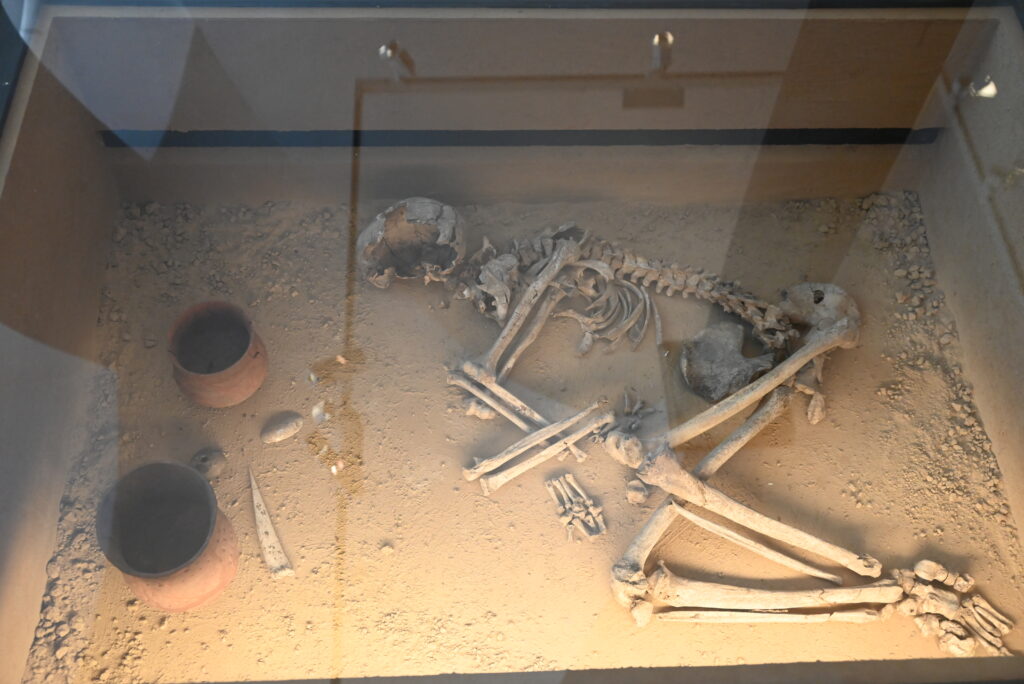
The Archaeological Museum has fascinating exhibits that date back, remarkably, from 600,000 BC through the early Middle Ages (800 A.D.) You get insights into the daily life of Paleolithic hunters and the first neolithic farmers, Bronze Age and Iron Age burials, the everyday life of Gallo-Romans, and jewelry and weapons unearthed from Frankish and Atamanic graves.
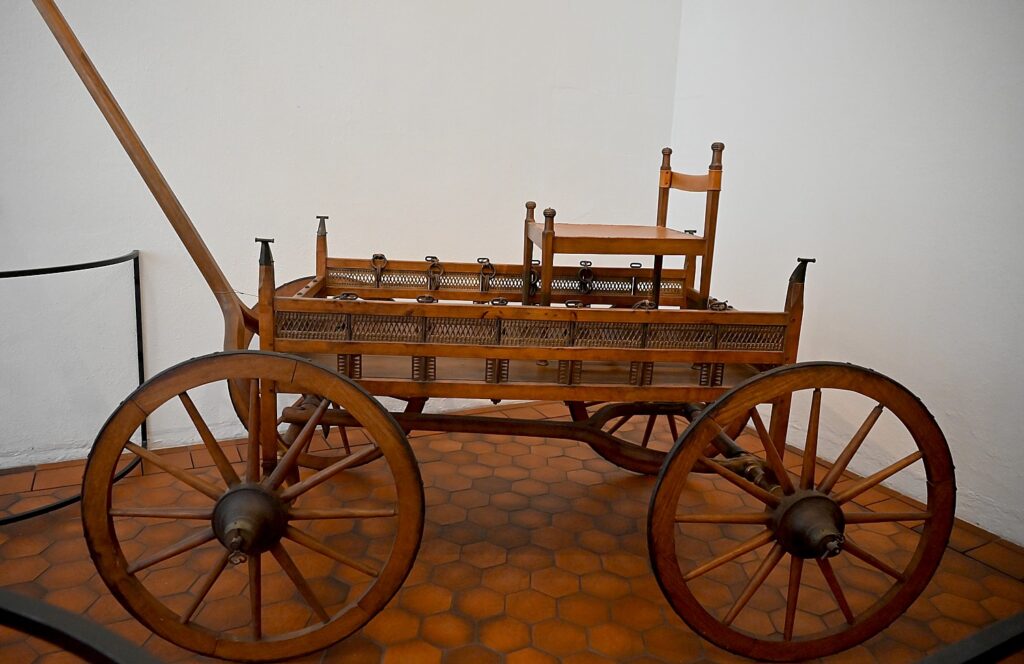
Among the highlights: A chariot for traveling through the world of the dead, taken from tombs of Celtic princes from the Iron Age (750 BC-050 BC). And you can see the oldest tool in Eastern France – a chopper made of rock used for slicing or scraping, that was found at Achenheim and dated about 600,000 B.C. There is also a funeral headstone of a Gallo-Roman farming couple wearing their everyday clothes, that dates from the late 3rd Century A.D.
Palais Rohan, 2 place du Chateau Strasbourg, +33 (0) 3 68 98 50 00, www.musees.strasbourg.eu.
Musée Historique de la Ville de Strasbourg
After returning from the canal cruise aboard the Panache and before taking the afternoon train back to Paris, I find my way down this really colorful street off Cathedral Square (that’s saying something in Strasbourg) to the Historical Museum of the City of Strasbourg. It is also not to be missed (and try to see early in your visit).
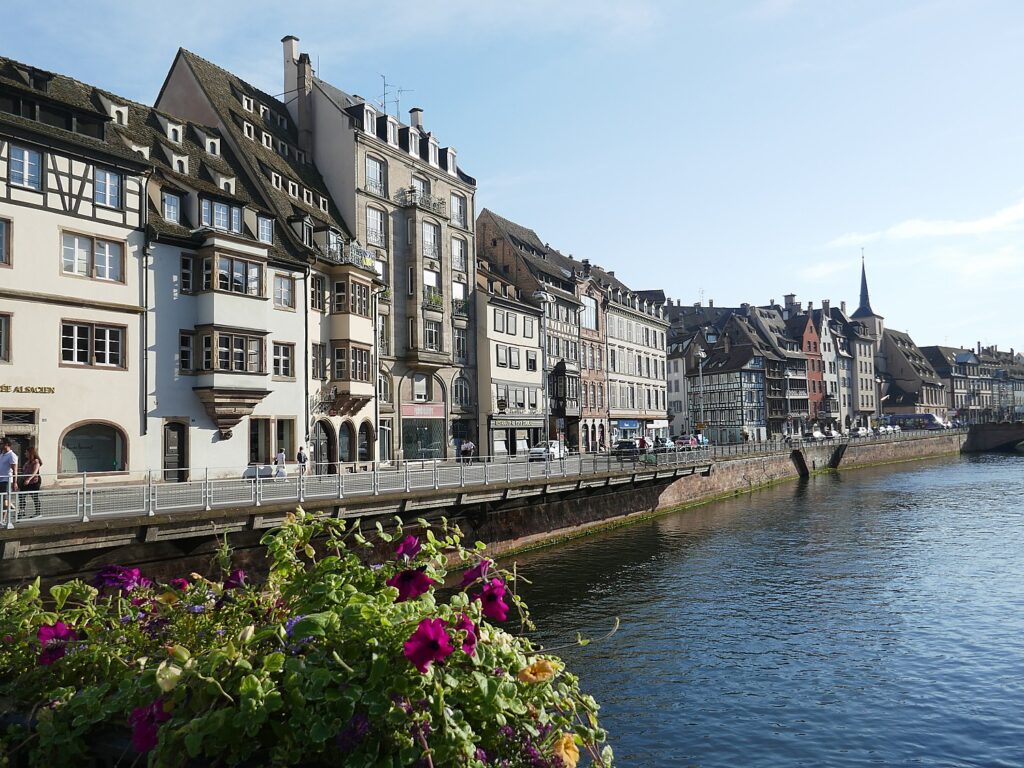
You wouldn’t believe that the museum, founded in 1920, is housed in what was the Grande Boucherie (the city’s slaughterhouse) built 1587-1588; it was renovated and reopened in 2013.
Entering the Musée Historique de la Ville de Strasbourg is like entering a time machine that transports you to exciting, dramatic periods of France’s history: Gutenberg’s printing press and the rise of a printing/publishing industry in Strasbourg, and what that meant. The French Revolution. The 1870 Commune Revolt. World War I. The Nazi Occupation and resistance. The museum offers an engaging tour lets you discover nine centuries of Strasbourg’s existence through 1700 works on display –paintings, artifacts, possessions – and interactive and digital devices.
Strasbourg was a free city of the Empire, which meant it had its own walls and enjoyed the privilege of holding a market and minting its own coins. Strasbourg did not take an oath of loyalty to the sovereign and did not owe the sovereign taxes or military, except for an escort for his coronation. Such a “free city” was rare. On this basis, Strasbourg had an independent constitution that was considered highly democratic by the standards of the day.
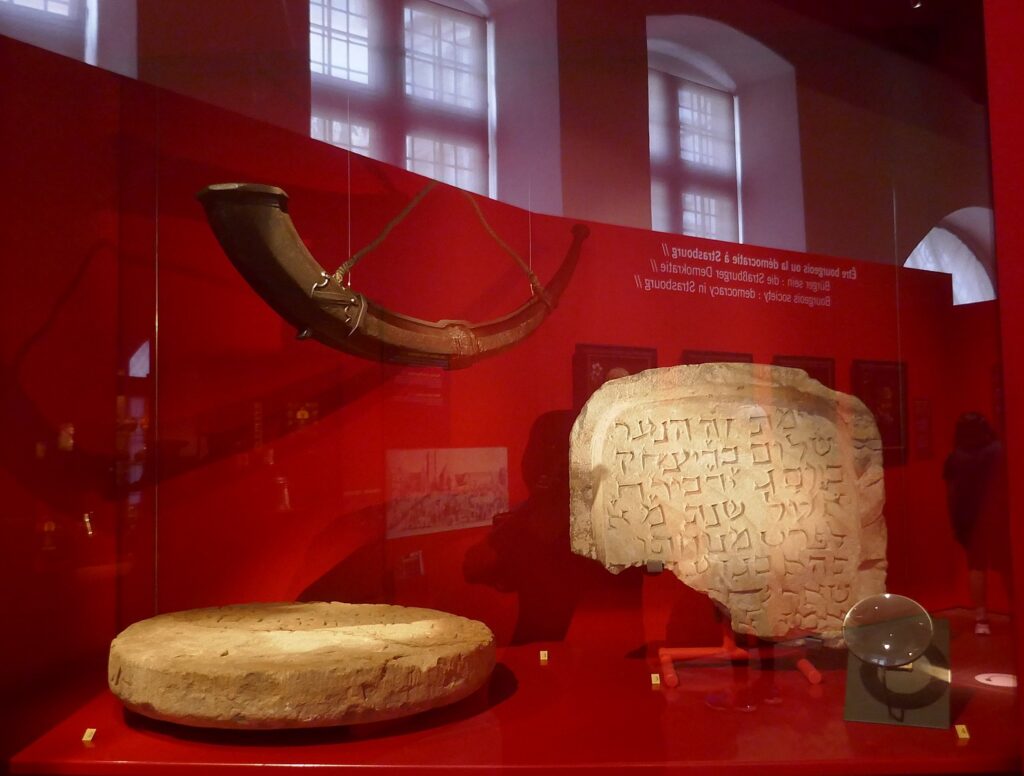
However, among those excluded from burgher status were servants, the poor and Jews, who were massacred in 1349, and after 1388, the survivors were denied the right to live in Strasbourg. The only activity Jews could lawfully engage in was usury (money lending), and certain trades. They could pursue these occupations in the city by day but had to leave in the evening. There is a moving display showing Jewish ritual objects (and as I had seen at the Musee de l’Oeuvre Notre Dame, a collection of Jewish tombstones).
There is an excellent display about Gutenberg, who developed his printing process in Strasbourg between 1434 and 1444 (legend has it he was inspired by seeing a wine press), then returned to his hometown of Mainz where he published his first printed volume in 1454. Gutenberg’s technological revolution spread with lightning speed. In Strasbourg some dozen printing houses sprang up between 1460 and 1480. The first publications were religious books (bibles) , classical texts and calendars.

The invention of printing, arbitrarily dated 1440, was celebrated in Mainz (as of 1837) and in Strasbourg, which raised the statue by David d’Angers honoring Gutenberg in 1840 (the statue we see today in Place de Gutenberg).
In the early days, printing was used to diffuse knowledge as well as criticism of the Church and of society in general. But authorities soon started printing decrees. In Strasbourg, the population was divided into six social classes – the first included servants and unmarried women; second class were day workers; third class were gardeners, and up to the sixth class, representing nobles, the Magistrate and jurists.
Laws promulgated by the municipality from 1531 onwards touched every aspect of life – religion, education, marriage, burial, use of inns, dress, begging, Jews, financial matters, games, behavior in the street, defamation, publishing.
One could say that the printing press enabled the “Rule of Law”.
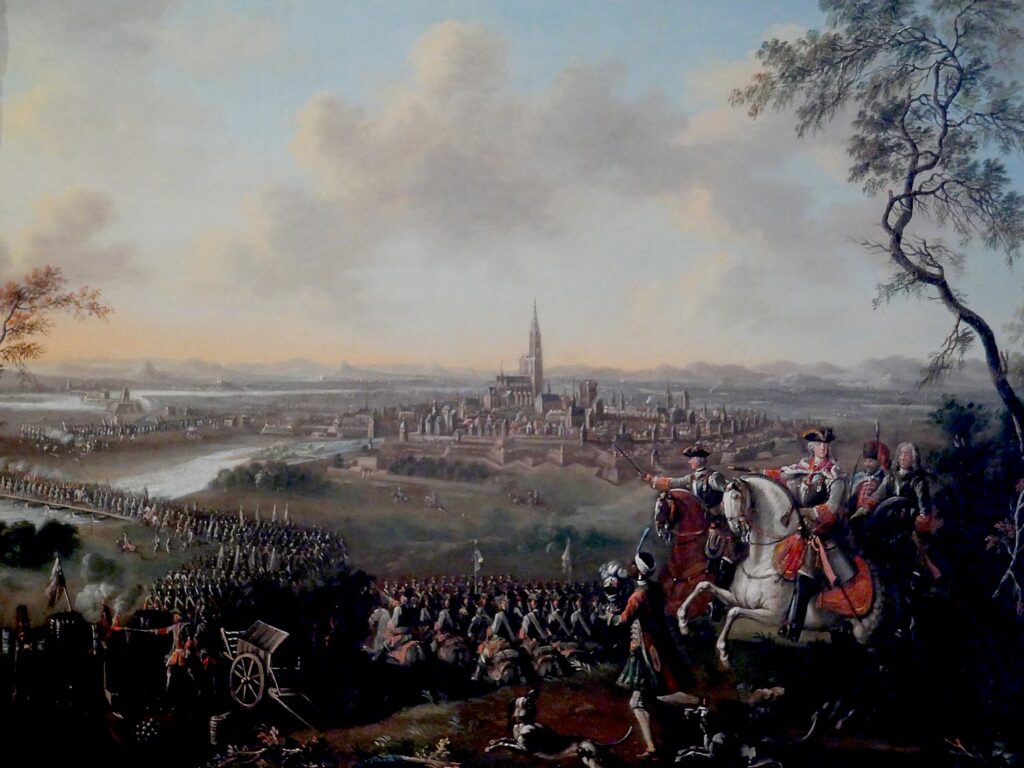
It is fascinating to travel through time – through the Imperial period, the French Revolution, the Commune, the back-and-forth between being part of France and the German Empire, World War I, World War II and Nazi occupation.
I learn that 22 Novembre – the name of a main boulevard where my hotel, the Hannong, is – was the date in 1918 when the French Army entered Strasbourg. “For President Poincare, the enthusiastic reaction of the population was equivalent to a plebiscite. French became compulsory in schools and the civil service. Strasbourg, the regional capital, had to re-adapt to the French system of departments. Religion, important in both educational and political terms, had to make concessions to the secular state.”
The extensive exhibits focused on the World War II period are intense.
In July1940, once Petain had signed the armistice, Alsatians were encouraged by the Vichy regime to return to their homes – exceptions were Jews, “Francophiles” and French civil servants (30% of the population) – their property was seized, and what followed was “Germanization” of the population (again, since Alsace had gone back and forth between Germany and France).
In November 1944, Strasbourg was liberated from the Germans by General LeClerc. Strasbourg was bombed by both Allies and by Germans after being liberated in 1944.
The European Union was founded in 1992 – three of its institutions are based in Strasbourg: the European Parliament, the European Mediator and the Schengen Information Service.
“A day will come when war will seem as absurd and as impossible between Paris and London, St. Petersburg and Berlin, Vienna and Turin, as today it would be impossible and seem absurd between Rouen and Amiens, Boston and Philadelphia,” Victor Hugo said in the inaugural speech at the Congress for Peace, Paris, August 21, 1849.
I don’t even remember how many hours I spent here – the displays are really captivating.
(Information and portal to collections: https://en.musees.strasbourg.eu/museums)
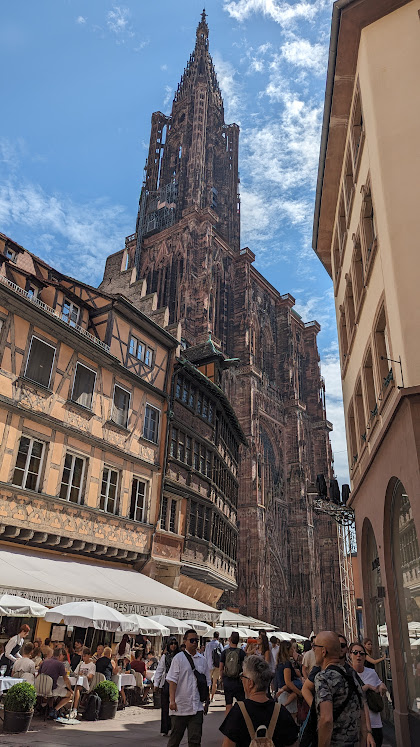
More information at https://www.strasbourg.info and https://www.visitstrasbourg.fr.
Next: Stepping into the Storybook that is Colmar
See also:
DISCOVERING STRASBOURG FRANCE’S CULTURAL RICHES
_______________________
© 2024 Travel Features Syndicate, a division of Workstyles, Inc. All rights reserved. Visit goingplacesfarandnear.com and travelwritersmagazine.com/TravelFeaturesSyndicate/. Blogging at goingplacesnearandfar.wordpress.com and moralcompasstravel.info. Visit instagram.com/going_places_far_and_near and instagram.com/bigbackpacktraveler/ Send comments or questions to [email protected]. Tweet @TravelFeatures. ‘Like’ us at facebook.com/NewsPhotoFeatures
